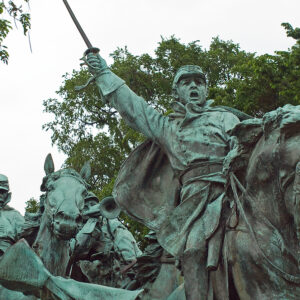The world was horrified by the recent concert massacre in Moscow. Hundreds of people enjoying an evening out were suddenly gunned down in a crime whose savagery staggers the mind.
The terrorists behind the atrocity consider themselves soldiers waging war. That’s not how the rest of us view them. But it does raise an interesting point.
It’s increasingly hard to tell these days where terrorism ends and warfare begins, to distinguish killing committed in the name of a cause from outright murder.
Previous generations also struggled with the same dilemma. Consider what happened in our own country nearly 163 years ago at an obscure Missouri waterway.
The Civil War is remembered as the time when Blue fought Gray. Yet, it also contained a murky war within a war whose participants didn’t wear uniforms or carry flags.
Nowhere was that carnage worse than in Missouri. A border state that permitted slavery, its people were bound by cultural ties to the South and economic bonds to the North. Here, the conflict was literally brother against brother, with entire families often divided.
Southern sympathizers living in northern Missouri were cut off from Confederates to the south. Some became guerrillas, small independent bands that struck targets of opportunity. Sometimes, the target was military; sometimes, it was civilian. In one deadly instance, it was both.
The brand-new Hannibal and St. Joseph Railroad was strategically important in 1861. Stretching from the Mississippi River to the Kansas line, it was as far west as America’s rails went at the time. It was so important that Ulysses S. Grant’s first Civil War command was guarding it.
The Hannibal and St. Joe (as locals called it) was the region’s premier transportation service. In 1860, it carried the very first letter delivered from St. Joseph by the Pony Express. In 1861, it was carrying troops and military supplies for the Union. And that caught the guerrillas’ attention.
On the moonless night of Sept. 3, they burned the 160-foot-long wooden railroad bridge over the Platte River a few miles outside St. Joseph. They torched the lower beams but left the top intact. Then they waited.
Shortly after 11 p.m., a westbound train chugged into view. The locomotive rolled onto the bridge. With its lower structure charred, there was nothing to support the weight. The bridge collapsed, and the engine plunged 30 feet into the river, spewing a geyser of scalding steam.
The baggage car, mail car, a few freight cars, and two passenger cars followed, landing atop one another like a crumpled accordion. People screamed. The river boiled. Survivors staggered through the darkness to a sandbar and collapsed.
Around midnight, Abe Hager, the train’s baggage master, climbed up the riverbank, found a railroad handcar, and rushed to St. Joseph for help. He rounded up dozens of volunteers (including every doctor in the city) and medical supplies; a train sped them to the scene.
Twenty people were killed. As many as 100 others were injured, some maimed for life. The dead included at least one soldier, a Lt. Shaw, traveling with a group of Union troops heading to Fort Leavenworth, Kan. Another fatality was Barclay Coppock, who had participated in John Brown’s infamous Harper’s Ferry Raid in 1859. Some guerrillas said they had hoped St. Joseph resident — and pro-Union former Missouri governor — Robert Marcellus Stewart would be aboard. (He wasn’t.)
People tended to view the attack from the perspective of the side they supported. Gen. Sterling Price, commander of the state’s pro-Confederate forces, wrote to his federal counterpart saying that since soldiers were among the train’s passengers, that qualified the attack as military sabotage; thus participants who were captured should be treated as prisoners of war. Nonsense, Union Gen. Henry Halleck replied, the attackers were “spies, marauders, robbers … in the garb of peaceful civilians” and would be hanged if caught.
In 2015, when an artist proposed a Civil War-themed mural for downtown St. Joseph that included the overturned train, city officials scrubbed the original design. The topic was still too hot to handle.
In fact, people couldn’t even agree on what to call the incident. Was it terrorism, warfare, or just plain murder? Defining it was every bit as hard back then as it is now.
So, folks settled on that sadly direct title: The Platte River Railroad Bridge Tragedy. Which sums it up perfectly.

